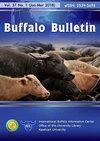综合治理水牛蝇-Haematobia exigua(双翅目:鹟科)的物理和生物防治方法
IF 0.2
4区 农林科学
Q4 AGRICULTURE, DAIRY & ANIMAL SCIENCE
引用次数: 0
摘要
水牛蝇(Haematobia exigua)是印度水牛和牛常见的体外寄生虫,会造成经济损失,因此有必要对其采取有效的控制策略。本研究计划评估几种物理和生物防治方法的杀幼虫活性,以综合治理水牛蝇(Haematobia exigua)。 通过体外检测和 Probit 分析评估了四种细菌生物控制剂,其中两种细菌,即苏云金芽孢杆菌(Bacillus thuringiensis var israelensis)和苏云金芽孢杆菌(Bacillus thuringiensis var kurstaki)对 H. exigua 表现出卓越的杀幼虫活性,半数致死浓度分别为每升水 134 毫克和 135 毫克。而另外两种细菌,即魏氏芽孢杆菌(Bacillus weihenstephanensis WSBC)和 KBAB4 则未能显示出理想的杀幼虫剂活性。由此可以得出结论,B ti 和 B tk 有望成为控制和综合治理水牛和角蝇的有效细菌制剂(BCA)。在实验室和田间进行了一项实验,以判断用聚乙烯薄膜紧紧覆盖粪堆的物理方法对控制水牛角蝇幼虫的效果。实验室结果表明,在用聚乙烯薄膜覆盖的粪便盆中,每 100 克粪便中只有 14.73% 的幼虫存活并发育,而对照组的幼虫存活率为 78.33%。在田间试验中,试验前粪坑中的平均幼虫数量为每 250 克粪便 86.33 头,用聚乙烯薄膜覆盖两周后,幼虫数量明显降低到 11.80 头。 这表明,覆盖粪坑的物理方法非常有效,因此可以作为有效的物理防治方法之一纳入虫害综合防治计划。本文章由计算机程序翻译,如有差异,请以英文原文为准。
Physical and bio-control methodologies for integrated management of buffalo fly-Haematobia exigua (Diptera: Muscidae)
Haematobia exigua, the buffalo fly, is a common ectoparasite of buffaloes and cattle in India causing economic losses and underlines the necessity of effective control strategies against them. The present study was planned to evaluate larvicidal activity of few methods for physical and biological control for integarated management of Haematobia exigua flies. Out of four bacterial bio-control agents evaluated by in-vitro assay and Probit analysis, two bacteria i. e. Bacillus thuringiensis var israelensis and Bacillus thuringiensis var kurstaki showed excellent larvicidal activity against H. exigua with LC50 value of 134 and 135 mg per liter of water respectively. Whereas, other two bacteria i. e. Bacillus weihenstephanensis WSBC and KBAB4 failed to show desired larvicidal activity. It can be concluded that B ti and B tk have future as effective bacterial agents (BCAs) in the control and integrated management of buffalo and horn fly. An experiment was conducted in the laboratory and on field for judging the efficacy of a physical method of tightly covering dung pats with polythene sheet for control of larvae of H. exigua. The laboratory result showed only 14.73% larvae were survived and developed per 100 gm of the faeces in the pot covered with polythene sheet as against significantly higher number 78.33% in the control group. During field trial, average larval count from dung pits before the experiment was 86.33 per 250 gm of faeces and it has been significantly reduced to 11.80 after covered with polythene sheets for two weeks. It indicated that physical method of covering the dung pits works immensely and thus can be inducted in IPM program as one of the effective physical control alternatives.
求助全文
通过发布文献求助,成功后即可免费获取论文全文。
去求助
来源期刊

Buffalo Bulletin
AGRICULTURE, DAIRY & ANIMAL SCIENCE-
CiteScore
0.50
自引率
0.00%
发文量
53
审稿时长
>12 weeks
期刊介绍:
Buffalo Bulletin is published quarterly in January-March, April-June, July-September and October-December. Contributions on any aspect of research or development, progress reports of projects and news on buffalo will be considered for publication in the bulletin.
 求助内容:
求助内容: 应助结果提醒方式:
应助结果提醒方式:


